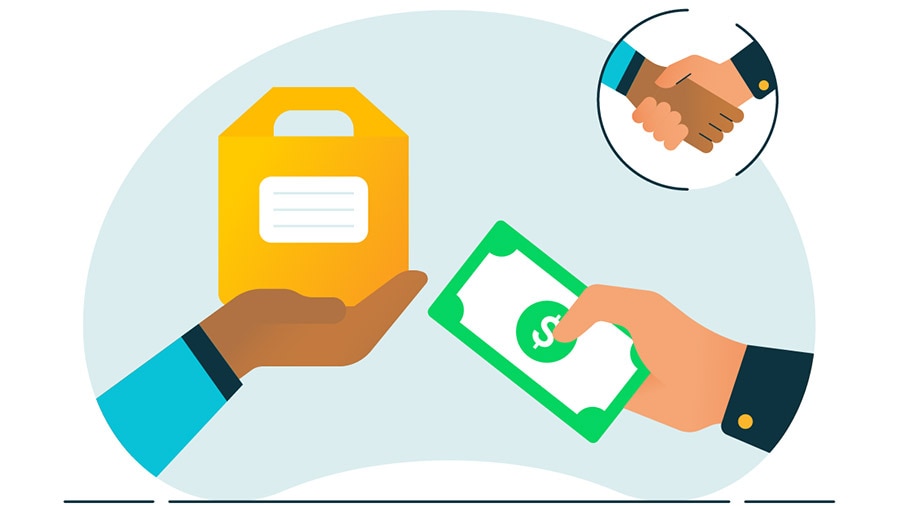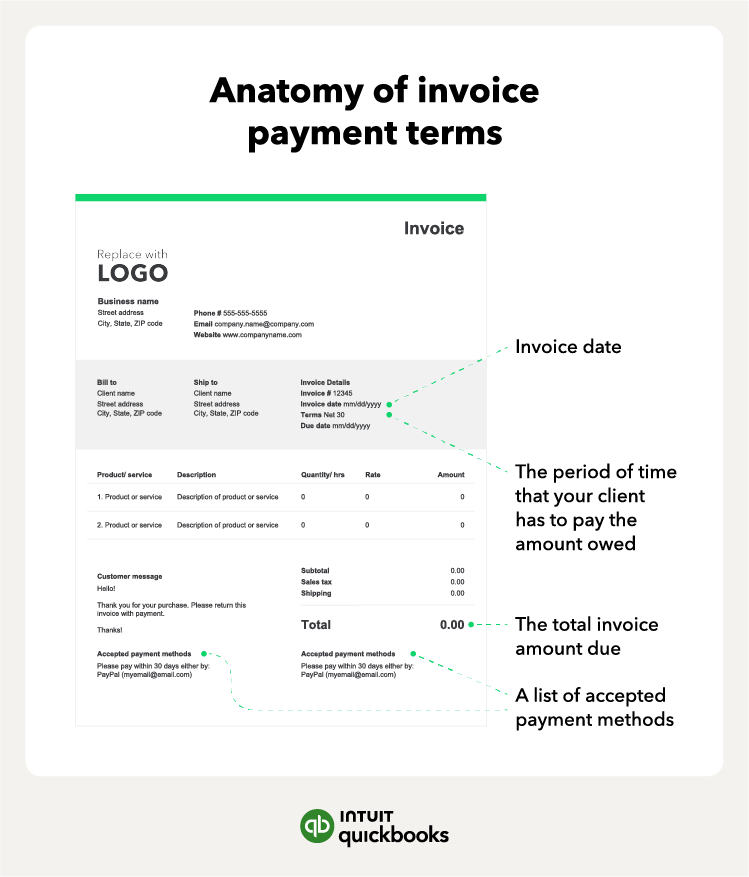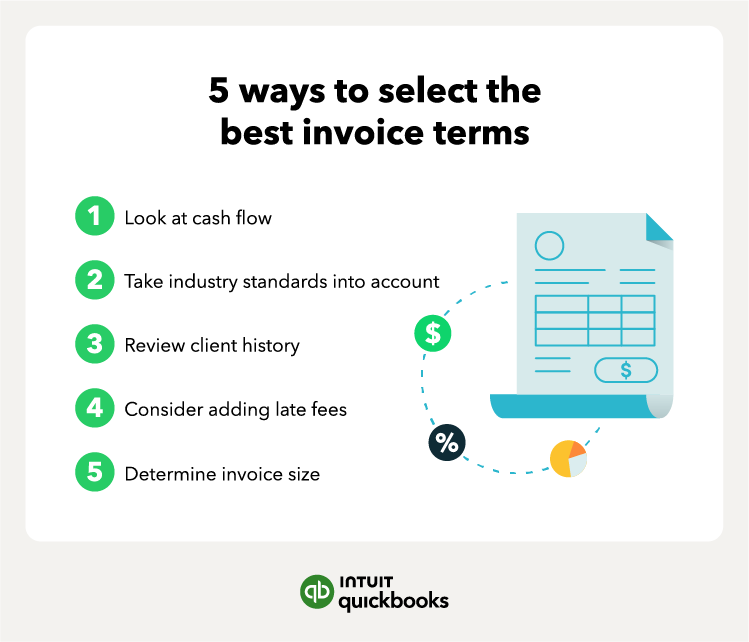18 Types of payment terms
Setting up an invoicing process with detailed payment terms is an essential part of business accounting. Payment terms make your payments a priority and set expectations for your customers, making client relationships feel more professional and productive. Once you have the payment terms nailed down, the next step is to think about how you could accept these different payment types, like partial payments or advanced payments.
- CIA: Cash in advance
- CBS: Cash before shipment
- CND: Cash next delivery
- COD: Cash on delivery
- CWO: Cash with order
- EOM: End of month
- PIA: Payment in advance
- 1MD, 2MD: Monthly credit payment of a full month (or two-month) supply
- 21 MFI: 21st of the month following invoice date
1. Cash in advance (CIA)
Cash in advance (CIA) is a payment term where the buyer pays the full amount before you deliver goods or services. This guarantees you get paid upfront and helps reduce the risk of non-payment.
Example: A furniture maker may require full payment before building a custom sofa. Similarly, an online store selling high-end electronics might ask customers to pay before shipping expensive products.
Best for:
- Businesses with high-value, custom, or made-to-order products that require significant upfront costs.
- International trade transactions where the seller wants to reduce risks associated with cross-border payments.
- Sellers working with new customers without a payment history.
Drawbacks
- Can deter potential customers who may be unwilling or unable to pay upfront.
- Might make a business less competitive compared to those offering delayed payment options.
2. Payment in advance (PIA)
PIA is an upfront payment before work begins. It can be a full payment, but it can also be a partial payment, like down payments or payments to help cover material costs or other expenses.
Example: A wedding photographer may require full payment before the event to prevent last-minute cancellations. For partial payments, a construction company may require 50% upfront before starting a home renovation, with the remaining 50% due upon project completion.
Best for:
- Businesses that need money upfront to cover costs, like custom orders or big projects.
- Companies that sell subscriptions or long-term services.
- Reducing the risk of cancellations, especially for service-based businesses.
Drawbacks:
- Some customers may not want to pay upfront before getting the product or service.
- It can make a business less competitive if others offer more flexible payment options.
3. Cash with order (CWO)
CWO means the buyer pays in full when placing the order, allowing you to approve and process the payment before you deliver goods or services to the customer.
Example: An online clothing store requires customers to pay at checkout before shipping their order. Also, a manufacturer may require full payment upfront before producing a large batch of custom machinery.
Best for:
- Custom or high-value products like industrial equipment or tailored clothing, where upfront costs are high.
- International trade to help sellers avoid risks like currency changes or non-payment.
- Industries with high upfront costs, like manufacturing and wholesale, where materials must be purchased before production.
Drawbacks:
- May limit your customer base, as some buyers prefer to pay after receiving goods.
- Can lead to lost sales if competitors offer more flexible payment terms.
4. Cash before shipment (CBS)
CBS means you receive full or partial payment before sending out goods.
Example: If you sell bulk wholesale products, you might require customers to pay in full before shipping large orders to protect your business from financial loss.
Best for:
- High-value or custom products that need upfront costs covered.
- Wholesale suppliers, where bulk orders involve large financial commitments.
- International sales, helping you avoid payment risks with foreign buyers.
Drawbacks:
- May discourage some buyers, especially those used to post-delivery payment terms like Net 30.
- Puts pressure on you to deliver on time since customers expect fast fulfillment after paying.
5. Cash on delivery (COD)
COD means you receive payment when the customer gets their order rather than upfront. This can help attract more buyers, especially those who prefer cash transactions or don’t trust online payments.
Example: If you run an online electronics store, you might offer COD so customers can inspect a smartphone before paying.
Best for:
- Businesses selling to customers who prefer cash payments or don’t have credit cards.
- Companies that want to build trust with new customers who might be hesitant to pay upfront.
Drawbacks:
- Some customers may refuse delivery, leaving you with extra shipping costs.
- You only get paid after delivery, which can slow down your revenue.
- Managing COD orders requires more logistics, security, and tracking, which can increase expenses.
6. Due upon receipt
Due upon receipt is a payment term that means the customer must pay the invoice after receiving it, usually by the next business day at the latest. This helps businesses get paid faster and improves cash flow.
Example:
A freelance graphic designer finishes a project and sends an invoice marked "due upon receipt." The client is expected to pay as soon as they receive the invoice.
Best for:
- Freelancers and small businesses that need fast payments to keep cash flow steady.
- One-time projects or services where immediate payment is expected.
Drawbacks:
- Some clients may struggle to pay right away, especially if they use longer payment cycles.
- Can create tension if customers are used to delayed payment terms.
7. Net 7/10/15/30/60/90
These terms refer to the number of days in which a payment is due. For instance, net 30 means that a buyer must settle their account within 30 days of the date listed on the invoice.
Example:
A construction materials supplier delivers a bulk order of lumber and cement to a contractor and issues an invoice with net 30 terms. The contractor has 30 days to make the payment, allowing time to complete part of the project before settling the bill.
Best for:
- Businesses working with larger companies that need time to process payments.
- Long-term clients where trust is established.
- Industries like wholesale and B2B services, where delayed payments are standard.
Drawbacks:
- Slower cash flow since payment comes after work is done or products are delivered.
- Risk of late payments, which can cause financial strain.
- Harder to manage expenses while waiting for funds.
8. End of month (EOM)
EOM is a payment term where the customer must pay by the last day of the month the invoice was issued. This means if you send an invoice on April 10th with EOM terms, the payment is due by April 30th.
Example:
A wholesale supplier delivers goods to a retailer on May 5th and issues an invoice the same day with EOM terms. The retailer must pay by May 31st, no matter when the order was placed during the month.
Best for:
- Businesses that want predictable cash flow by aligning payments with monthly cycles.
- Clients who close their books at the end of the month, making it easier for them to process payments.
Drawbacks:
- If you send an invoice late in the month, the customer has only a few days to pay.
- Some clients may struggle to pay on time, especially if they receive multiple EOM invoices from different suppliers.
9. Month following invoice (MFI)
MFI is a payment term where the payment is due on a specified day of the month after the invoice date.
Example:
If you issue an invoice on January 10th with "21 MFI" terms, the payment is due on February 21st. This provides the client with additional time beyond standard net terms to arrange payment.
Best for:
- Customers who need more time to process payments due to internal approvals or financial cycles.
- Building strong relationships by offering flexible terms that work for long-term clients.
Drawbacks:
- Slower cash flow, since you wait longer to receive payment.
- Higher risk of late payments, as longer terms can lead to delays or missed due dates.
10. 2/10 Net 30
2/10 Net 30 means you offer a 2% discount if the buyer pays within 10 days. If they don’t, they must pay the full amount within 30 days.
Example: You send an invoice for $1,000 with 2/10 Net 30 terms. If the customer pays within 10 days, they get a $20 discount and only pay $980. If they pay later, they must pay the full $1,000 by day 30.
Best for:
- Getting paid faster by giving buyers a reason to pay early.
- Encouraging reliable payments, which reduces late or overdue invoices.
- Building good relationships with customers by offering them savings.
Drawbacks:
- You make less money per sale due to the discount.
- It can hurt profits if your business has tight margins.
11. Installment agreements
An installment agreement lets customers pay over time instead of all at once. This makes high-priced items more affordable for buyers while giving you a steady income stream.
Example: If you sell equipment for $10,000, instead of requiring full payment upfront, you allow the customer to pay $1,000 per month for 10 months.
Best for:
- High-cost products or services, like cars, machinery, or real estate, where customers may need payment flexibility.
- Attracting more buyers by making purchases more affordable through smaller payments.
- Creating a steady cash flow by receiving payments over time rather than in one lump sum
Drawbacks:
- Risk of missed payments, meaning you may have to chase customers for overdue balances.
- More work to manage since tracking multiple installment accounts takes time and effort.
- Slower revenue, as you don’t get the full payment upfront, which could impact your cash flow.
12. Lines of credit
A line of credit offers buyers financing toward products and services. Customers can then repay the balance on the agreed payment schedule.
Example: A wholesale supplier provides a retailer with a $50,000 line of credit. The retailer can order products as needed, up to this limit, and agrees to pay the balance within 30 days of each purchase.
Best for:
- Businesses that want to build long-term relationships by offering flexible payment options.
- Encouraging larger purchases, as customers may buy more when they don’t have to pay upfront.
- Companies working with established, reliable clients who have a history of making on-time payments.
Drawbacks:
- Since customers pay later, your business may have to wait for revenue.
- Some customers may pay late or default, leading to financial losses.
- Tracking credit accounts, sending reminders, and collecting overdue payments require extra time and resources.
13. Partial payment
You may choose to require a partial payment of the total cost of a customer’s purchase, with the remaining balance paid over an agreed-upon schedule. This helps make expensive products or services more affordable while ensuring your business gets some payment right away to cover costs.
Example: A home renovation company charges $20,000 for a kitchen remodel. Instead of requiring full payment upfront, the company asks for a 50% deposit ($10,000) before starting the project, with the remaining $10,000 due upon completion.
Best for:
- Expensive products or services like custom furniture, home renovations, or specialized equipment.
- Keeping cash flow steady by covering initial costs upfront.
- Attracting more customers by offering flexible payment options.
Drawbacks:
- Risk of non-payment if a customer fails to pay the remaining balance.
- More work to manage payments since it requires tracking and follow-ups.
- Slower revenue since full payment isn't received upfront.
14. Cash next delivery (CND)
CND means your customer must pay for their last order before they receive their next delivery. This ensures you get paid for previous shipments before sending new ones so you can manage cash flow and reduce unpaid invoices.
Example: A wholesale food supplier delivers fresh produce to restaurants weekly. Under CND terms, the restaurant must pay for last week’s delivery before receiving this week’s shipment.
Best for:
- Businesses with regular deliveries, like wholesalers or B2B suppliers.
- Managing credit risk, making sure you get paid before continuing business.
- Keeping cash flow steady so your business doesn’t run into payment delays
Drawbacks:
- Extra tracking is needed, as you must make sure past invoices are paid before shipping new orders.
- Possible delivery delays if customers don’t pay on time, which can affect their supply and your sales.
15. Subscriptions and retainers
Subscription and retainer payment terms require customers to pay regularly, such as monthly or annually. Typically, businesses on retainer agreements issue invoices to clients on a recurring basis.
Example: A marketing consultant offers a monthly retainer where clients pay a set fee every month for a certain number of service hours. This guarantees the consultant steady work and ensures the client has consistent support.
Best for:
- Ongoing services, like legal, marketing, or IT support, where clients need continuous help.
- Steady cash flow, so your business has predictable income each month.
- Building strong client relationships, as customers commit to long-term agreements.
Drawbacks:
- You must allocate time and resources consistently, which may limit flexibility for other projects.
- Clients might expect extra work beyond the agreed services.
- Regular payments might lead to decreased motivation to provide exceptional service if not managed carefully.
16. Cash against documents (CAD)
CAD is a payment term used primarily for international shipping transactions. You ship goods, but the buyer can’t get the shipping documents until they pay. The documents are sent to the buyer’s bank, and once payment is made, they can collect the goods.
Example: A textile exporter in India ships fabric to a retailer in Germany. The exporter’s bank sends the shipping documents to the retailer’s bank. The retailer must pay their bank before receiving the documents needed to claim the goods from customs.
Best for:
- International sales, where you want payment security but don’t want the cost of a letter of credit.
- Selling to buyers you don’t fully trust yet since you still control the shipment until payment.
Drawbacks:
- If the buyer refuses to pay, you may struggle to reclaim or resell the goods.
- Once the shipment is sent, it can be hard to get it back if payment issues arise.
- Slow processing by the buyer’s bank can delay payment and shipment release.
17. Contra
A contra payment happens when two businesses owe each other money, and instead of paying separately, they offset the amounts against each other.
Example: Your business sells $1,000 worth of office supplies to a supplier, while you buy $800 worth of raw materials from them. Instead of both making full payments, the $800 is deducted from the $1,000, and the supplier only pays you the $200 difference.
Best for:
- Businesses that buy and sell from each other, like wholesalers and manufacturers.
- Simplifying transactions by reducing the number of payments going back and forth.
Drawbacks:
- Requires careful bookkeeping, as both companies must agree on the amounts.
- If one party disagrees on the balance., there could be potential disputes.
- Only works if both businesses have invoices with each other at the same time.
18. 1MD and 2MD
1MD and 2MD are credit payment terms where customers receive a one-month (1MD) or two-month (2MD) supply of goods and agree to pay at the end of that period. This lets businesses sell on credit while making sure they get paid within a set timeframe.
Example: A wholesale office supplies company provides a retailer with a one-month supply of products under 1MD terms. The retailer must pay by the end of the month. Under 2MD terms, the retailer gets a two-month supply and pays at the end of the second month.
Best for:
- Businesses with regular supply schedules, such as wholesalers and manufacturers.
- Building strong customer relationships by offering flexible credit terms.
- Helping customers manage inventory so they have steady stock without upfront costs.
Drawbacks:
- Risk of late or missed payments, which can affect your cash flow.
- Requires careful tracking since multiple customers may have different payment deadlines.
- If customers order too much and struggle to sell the inventory, there’s potential for overstock.


















